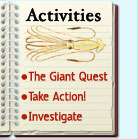 |
To Market, To Market
The giant squid is a mollusk, a group of soft-bodied invertebrates that includes clams, oysters, snails, slugs, mussels, and octopus. Next time you’re at a fish market, see how many mollusks you can find. You might even ask your parents if you can take home a sample or two for you to dissect. In some small squid, you may even find a beak intact! For something a little less messy, create a menu for an imaginary “Mollusk Café.” Under each item, include a short description.
Super Strong Suckers
All along the giant squid’s arms and tentacles are powerful, round suckers. They work like suction cups to grab on to prey and fight off predators. See for yourself how strong suction cups can be. First, find a small, plastic suction cup like the ones that hold up signs or pictures on windows. Tie a string to the suction cup. (It usually has little metal rings on the outside.) Now moisten the suction cup and press it into the center of an empty CD case. Lift the string. Can you pick up the case? Try something a little heavier, just be sure it’s not breakable and has a smooth surface.
How can a tiny suction cup support such a big weight? It’s like this: Even though we can’t feel it, the air around us has pressure, pushing down on everything. When you press a suction cup onto a surface, you push out the air. Now there’s less air – and less pressure – inside the suction cup. This creates a vacuum that seals the suction cup to the surface, until you lift the side and let the air rush in again.
Power Propulsion!
Giant squid can burst through the ocean waters by squeezing water through a funnel. Can you think of a way to use this same kind of “jet propulsion” with air instead of water? Take a toy car, a rubber band or string, and a balloon and see what you come up with. As you set it up, think about how the direction of the air relates to the direction the car will move.
Sea Creature Charades
If you think the giant squid’s jet propulsion is an unusual way of getting around, explore some of the other strange swimmers in the ocean. Here are just a few animals that have cool ways of moving about: jellyfish, eels, starfish, sea horses, flying fish, and manta rays. Learn about how these sea creatures get around, and add your own to the list. Then play charades by acting out the different motions for friends and family and see if they can guess what ocean animal you are. Arrange to visit a local aquarium to see different ocean animals in action.
How Big Is GIANT?
The giant squid can grow up to 60 feet long, including its
arms and tentacles. How big is that compared to some of earth’s
other enormous creatures? Create a mural with a graph showing
how the giant squid compares in size to the African elephant
(10 feet tall), sperm whale (60 feet long), blue whale (100
feet long), and even the Brachiosaur (85 feet long).
Animals Afloat
How do such large ocean animals like the sperm whale and the giant squid stay afloat in the ocean without sinking to the bottom? Try this activity to learn about buoyancy, or the tendency to float. Go outside with a bucket of water and a clean, empty jar. Next, find a bunch of rocks in different sizes. Place the rocks in the water. Did they sink or float? Now make sure the top of the jar is screwed on tight, and set it in the water. Did it float? Next, put the smallest rock in the jar, screw the lid on tight, and put the jar in the water. Are you surprised by what happens? One by one, keep adding rocks in the jar, each time checking to see if the jar still floats. What’s happening?
Find Fossils!
Did you know that amazing fossils of marine invertebrates have been found in the state of New Jersey? That’s because the region was under water millions of years ago. Find out what kinds of fossils have been found in your own state at: www.paleoportal.org/index.php?globalnav=fossil_gallery. (Click your state, then search the fossil gallery. If there are no fossils, check out the Web sites for your state.) You can often find fossils at your local natural history museum. Choose some of your favorite fossils and make “fossil trading cards.” On one side of an index card, draw a picture of the fossil. On the other, write important facts, like its name, the period it lived, and its actual size.
Spin a Squid Story
For hundreds of years, the mysterious giant squid has inspired many legends, books, and movies. Over 500 years ago, sailors in Norway told tales of an enormous sea monster, which they called Kraken. According to the legend, the huge creature with many long arms would wrap its arms around a passing ship and pull it underwater. Homer’s Odyssey and the novels Moby Dick and 20,000 Leagues Under the Sea described similar monsters. Giant squid have also appeared in lots of movies, like Reap the Wild (1942), A Voyage to the Bottom of the Sea (1961), The Beast (1996) and three film versions of 20,000 Leagues Under the Sea (1916, 1954, 1997). Explore some of these or other stories about giant squid. Then try writing your own tale about the giant squid. Use your imagination, but take what you’ve learned about this mysterious creature to make your tale believable.
|
 |



